March 24th Scots Book of Days
MARCH 24 New Year’s eve from Ceasar until 1598 (in Scotland) and 1750 (In England).
1396 Walter Hilton of Thurgarton, Augustinian Canon, Mystic,
1443 James the Gross, died 7th Earl Douglas, prudent and peaceful, 2nd son of the 3rd Earl Douglas, succeeded his grand nephew William 6th Earl Douglas, which William died at age 16. Anderson v. 2 p. 45.
1495 Archibald Campbell, 2nd Earl of Argyll (died 1513), Lord Chancellor of Scotland, Master of the Royal Household of James IV of Scotland.
- Campbell Earl of Argyll 1010 2Montgomery2Blair 2Cochrane2Miller 2Simmons2Choate to Zoë TOAG
Campbell Motto: NE OBLIVISCARIS. [from Latin: “Do not forget”]. Badge: fir club moss, or wild myrtle (bog myrtle) Chief: Torquhil Ian Campbell, 13th Duke of Argyll Seat: Inveraray Castle, Argyll and Bute Though abundant in Argyll, Bog Myrtle drops its leaves in winter.
 Crest: On a boar’s head erased fessways erased Or, armed Argent, langued Gules.
Crest: On a boar’s head erased fessways erased Or, armed Argent, langued Gules.
1550 The treaty of Norham (24 March 1550) established a truce between the nations for ten years; and in 1552, the Wardens of the Marches consenting, the debatable land ceased to be matter for debate, the parish of Canonbie being annexed to Dumfriesshire, that of Kirkandrews to Cumberland. After the battle of Solway Moss (1542) the shires of Kirkcudbright (or East Galloway or “Stewartry of Kirkcudbright”), and Dumfries fell under English rule for a short period. Previously, in 1455 the great stronghold of the Thrieve, the most important fortress in Galloway, which Archibald the Grim had built on the Dee immediately to the west of the modern town of Castle Douglas, was reduced and converted into a royal keep. (It was dismantled in 1640 by order of the Estates in consequence of the hostility of its keeper, Lord Nithsdale, to the Covenant.) The famous cannon Mons Meg, now in Edinburgh Castle, is said to have been constructed in order to aid James III in this siege.
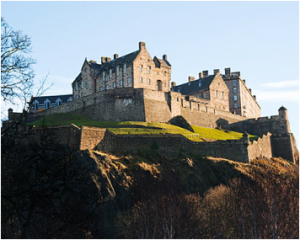 Edinburgh Castle sits atop Edinburgh’s Castle Rock, and is the oldest surviving building in the Scottish capital. Known as St. Margaret’s Chapel, this chapel dates back to the early twelfth century, while the castle itself was founded around the year 1000. The earliest version of Edinburgh Castle was built by Malcolm III, and he shared it with his Saxon queen, who would eventually be venerated as St. Margaret. Malcolm III’s son, David I, who erected the first formidable castle on the Edinburgh Castle site, and this occurred around the year 1130. Approximately 40 years later, David I’s successor, King William, was captured by the English during the Battle of Alnwick, and among the things that he had to surrender in order to secure his release was Edinburgh Castle. The English occupied the structure for twelve years before returning it to King William.
Edinburgh Castle sits atop Edinburgh’s Castle Rock, and is the oldest surviving building in the Scottish capital. Known as St. Margaret’s Chapel, this chapel dates back to the early twelfth century, while the castle itself was founded around the year 1000. The earliest version of Edinburgh Castle was built by Malcolm III, and he shared it with his Saxon queen, who would eventually be venerated as St. Margaret. Malcolm III’s son, David I, who erected the first formidable castle on the Edinburgh Castle site, and this occurred around the year 1130. Approximately 40 years later, David I’s successor, King William, was captured by the English during the Battle of Alnwick, and among the things that he had to surrender in order to secure his release was Edinburgh Castle. The English occupied the structure for twelve years before returning it to King William.
The history of Edinburgh Castle sees the king of England, Edward I, taking control after a three-day siege in 1296. In 1314, the structure was recaptured by the Scots, only to be retaken by the English in 1334. www.destination360.com/europe/uk/edinburgh-castle.
As the Douglases went down the Maxwells rose, and the debatable land on the south-east of Dumfriesshire was for generations the scene of strife and raid, not only between the two nations but also among the leading families, of whom the Maxwells, Johnstones and Armstrongs were always conspicuous.
- Armstrong17th 2Warren2Mehew2Luther2Choate Zoë
Even when the crowns of Scotland and England were united in 1603 turbulence continued; for trouble arose over the attempt to establish episcopacy, and nowhere were the Covenanters more cruelly persecuted than in Galloway. Kirkcudbrightshire became part of the Dumfries and Galloway Region in 1975, as the District of Stewartry (which retained a district council until 1996). It maintains a strong regional identity and is a Lieutenancy Area.
Johnstone Crest: A winged spur Or. Motto: NUNQUAM NON PARATUS. [from Latin: “Never unprepared”]. Badge: red hawthorn Chief: Patrick Andrew Wentworth Johnstone of Annandale and of that Ilk, 11th Earl of Annandale and Hartfell
John Wishart, Laird of Pitarro; March 24, 1551, a precept of charter was granted to John Wishart, the lands of Bathaggarties in the lordship of Mar (One of 24 Lords of the Congregation. George Wishart, martyred 1546 March 1)John Wishart1 M, #20547, John Wishart lived at Pitarrow, Scotland. Child of John Wishart – Margaret Wishart
Citations Charles Mosley, editor, Burke’s Peerage, Baronetage & Knightage, 107th edition, 3 volumes (Wilmington, Delaware, U.S.A.: Burke’s Peerage (Genealogical Books) Ltd, 2003), volume 1, page 952. Hereinafter cited as Burke’s Peerage and Baronetage, 107th edition.. Margaret Wishart1 F, #20546. Margaret Wishart was the daughter of John Wishart. She married David Lindsay of Edzell, son of Sir David Lindsay, Lord Edzell (d. 1610) and Lady Helen Lindsay. Her married name became Lindsay.1
Child of Margaret Wishart and David Lindsay of Edzell
Alexander Lindsay. Citations Charles Mosley, editor, Burke’s Peerage, Baronetage & Knightage, 107th edition, 3 volumes(Wilmington, Delaware, U.S.A.: Burke’s Peerage (Genealogical Books) Ltd, 2003), volume 1, page 952. Hereinafter cited as Burke’s Peerage and Baronetage, 107th edition
Edzell (Scots: Aigle, Scottish Gaelic: Eigill) is a village in Angus, Scotland. It is 5 miles (8 km) north of Brechin, by the River North Esk. Edzell Castle, a motte and bailey. In 1861, Queen Victoria and Prince Albert visited Edzell, as part of a Royal progress through Angus and Kincardineshire, just weeks before Albert’s sudden death.
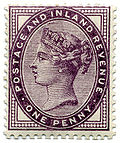 Victoria “Penny Lilac” of 1881; 16 dots in each corner
Victoria “Penny Lilac” of 1881; 16 dots in each corner
1564 [Palm Sunday] Knox stirred controversy again, when he married Margaret Stewart, the daughter of an auld friend, Andrew Stewart, a member of the Stuart family and a relative of the queen, Mary Stuart. The marriage was unusual because he was a widower of fifty, while the bride was only seventeen. Very few details are known of their domestic life. They had three daughters, Martha, Margaret, and Elizabeth.
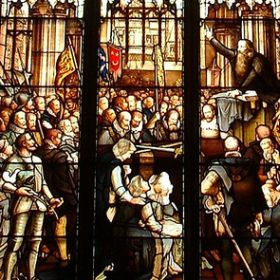 St Giles Cathedral window, Edinburgh. Licensed under Creative Commons by Sleepless in Somerset on Flickr.
St Giles Cathedral window, Edinburgh. Licensed under Creative Commons by Sleepless in Somerset on Flickr.
Robert Millar I of Ochiltree, was admitted, between 24 November and 15 December 1661 at St. Conal’s Ochiltree. Before the Reformation, the church had belonged to Melrose Abbey, and contained an altar of St. Mary.
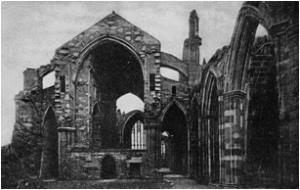 Melrose Abbey. The Spell of Scotland by Keith Clark, 1916 to the Lord Marischall, Boston The Page Company. P.34.
Melrose Abbey. The Spell of Scotland by Keith Clark, 1916 to the Lord Marischall, Boston The Page Company. P.34.
This was where on Palm Sunday 1564, [26 March 1564] Knox and Queen Mary, 1561–1564) John Knox married Margaret, daughter of Lord Ochiltree, Robert’s great-great-aunt. John Knox’s will shows that Andrew, 2nd Lord Ochiltree, though known as ‘the guid Lord,’ was often in sufficient financial straits to borrow from his son-in-law. Baron Castle Stewart Andrew’s grandson, third Lord Ochiltree, though gentleman of the bed-chamber to James VI and Governor of Edinburgh Castle, was in even worse case: in 1615 he sold his barony and resigned his title to his cousin Sir James Stewart of Killeith, and went to Ireland for a fresh start. In 1619 he was created Baron Stuart of Castle Stuart in the Irish peerage and lived until 1672. The Ochiltree title lapsed in 1675, on the death of Sir James’s son William.
Over Fork Over
One of the houses in Ochiltree carries the legend, on a plaque above the door, ‘Over Fork Over.’ People in the village say that once when troops came looking for Covenanters, a farmer hid a number of them under a load of hay. Familiar with this form of deception, the troop commander ordered a soldier to thrust a pitchfork into the load. As he raised it, the driver whispered, ‘Over, fork, over’; the soldier took a shallow dip, the Covenanters went unpricked and undiscovered. But Robertson’s Ayrshire Families, Vol. I p. 246 derives it from the Cunninghames’ arms ” The family assisted Malcolm, son of Duncan, to escape from Macbeth by hiding him in a barn. 71YYMA
1586 Methven Castle was granted to Ludovic Stewart, 2nd Duke of Lennox on 24 March 1586; the Duke’s first wife was Sophia Ruthven, granddaughter of the first Lord Methven, niece of the second Lord Methven and first cousin of the last Lord Methven.
1599 March 24th, never happened in Scotland. The dates went from March 24th 1598 to March 25th 1599 (1st day of 1599) to December 31, 1599 to January 1st, 1600, January 2nd , 3rd , 4th, 5th, 1600. Dating its years from the birth of Jesus Christ, so that ‘’ every nation, kindred, every ear shall hear, every knee shall bow, and every tongue shall confess, Jesus Christ is Lord,’’ thru computer software applications and aviation, the Christian calendar has been adopted world wide for the Musselmen of Islam, the Buddhist, Confucian, Hindu, nativist, Jew, agnostic, or atheist (Isaiah 45:23, 1 Kings 19:18, Philippians 2:11, Romans 14:11, confirmed in modern times Mosiah 16:1, 27:31, Doctrine and Covenants 76:110, 88:104.)
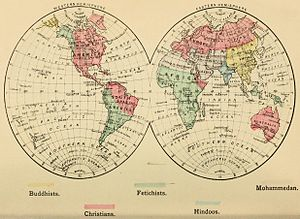 An 1883 map of the world divided into colors representing “Christians, Buddhists, Hindoos, Mohammedans, Fetichists”. August went from the 6th month in 1598 to the 8th month in 1600.
An 1883 map of the world divided into colors representing “Christians, Buddhists, Hindoos, Mohammedans, Fetichists”. August went from the 6th month in 1598 to the 8th month in 1600.
1593 petition. In 1585 August St Andrews [University] dispersed the students from pest, impoverishing the town to submit a petition March 24 1593 for poverty. 400 died at St Andrews from plague. A History of Epidemics in Britain from A.D. 664 to the Extinction of Plague Charles Creighton, M.A. M.D. Demonstrator of Anatomy University of Cambridge. 1891
1603 James I of England (James VI, King of Scots) becomes King of England Union of the Crowns in 1603.
1649 capitulation of Pontefract Castle which, even after the death of Charles I, remained loyal to Charles II.
1751 did not occur in England, Ireland, British North America, and British colonies as 1751 only had 282 days due to the Calendar Act of 1750. But 1751 did occur in Scotland, as 1751 had 365 days. The world’s oldest lunar “calendar” is in an Aberdeenshire field.
1752 No longer New Year’s Eve. The English civil year started on 25 March until January 1, 1752 (Scotland having changed to 1 January in 1600). Auld style dates would be a year earlier than the new style for days between 1 January and 24 March. Eleven days did not occur in September 1752 in both England and Scotland as well as other British controlled territories (when the day after 2 September was 14 September), so as to bring the British Empire fully in line with the Gregorian calendar.
1783 Duchess of Albany created 24 March 1783 or before for Stuart became extinct 14 November 1789 for Charlotte, natural daughter of King Charles III by Clementina Walkinshaw- Walkinshaw. Crest: A martlet. Motto: IN SEASON.
1824 William Weatherford, (c. 1765 – March 24, 1824)Creek (Muscogee) military, nephew of Alexander McGillivray, Creek (Muscogee brigadier general. William is son of Charles Weatherford, a Scots trader. Creek War veteran.
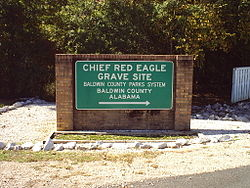 Chief Red Eagle grave site, Baldwin County marker
Chief Red Eagle grave site, Baldwin County marker
1887 Roscoe Arbuckle, Roscoe Conkling “Fatty” Arbuckle (March 24, 1887 – June 29, 1933, of Scottish descent.
1930 Terence Steven “Steve” McQueen born in Indiana. (died November 7, 1980 from surgery smoking related lung cancer and mesothelioma and asbestos exposure). Private First Class U.S. Marine Corps from 1947 to 1950 including Arctic duty, and honor guard for US President’s Harry Truman’s yacht. Wikipedia gives 11 words to McQueen’s Christmas of 1969 movie ‘The Reivers.’ Border Reivers (Scots for rob) were raiders along the Anglo–Scottish border from the late 13th century to the beginning of the 17th century.
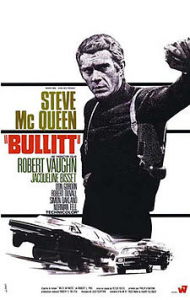 Poster for 1968 movie Bullitt. McQueen nominated for Academy Award.
Poster for 1968 movie Bullitt. McQueen nominated for Academy Award.
2014 Scottish teenage musician uses talents to share the gospel. In the year since 18-year-old Scottish musician Benjamin Hunter auditioned for the Mormon British Pageant, he has released his first album, featuring hymns and songs of faith inspired by his musical journey. Hunter, a third-generation member of The Church of Jesus Christ of Latter-day Saints, has lived his entire life in Airdrie, a small town in North Lanarkshire, Scotland. Hunter said confidence has played a large part in his ability to live the gospel and be an example to others.
“I think it depends on how confident you are to speak up and share the gospel with others, and that’s what determines how easy or difficult it can be for you,” Hunter told the Deseret News.
Hunter grew up as “one of two or three” members of the Church of Jesus Christ in his high school. “Some people don’t even get that lucky in Scotland, so (living the gospel) can be tricky,” he said.
While performing in the British Pageant, Hunter was introduced to representatives from the Priesthood Department and Church Office Building in Salt Lake City, who invited him to be part of the “Savior of the World” production at the Conference Center. Hunter was cast in two roles for the production later that fall.
Utah Standard News depends on the support of readers like you.
Good Journalism requires time, expertise, passion and money. We know you appreciate the coverage here. Please help us to continue as an alternative news website by becoming a subscriber or making a donation. To learn more about our subscription options or make a donation, click here.
To Advertise on UtahStandardNews.com, please contact us at: ed@utahstandardnews.com.


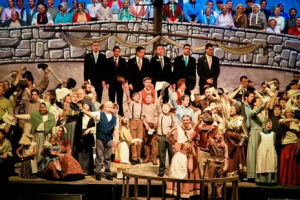
Comments - No Responses to “March 24th Scots Book of Days”
Sure is empty down here...